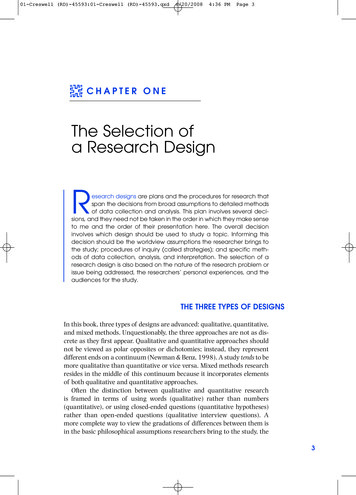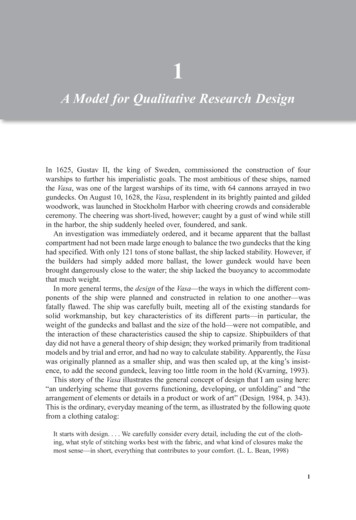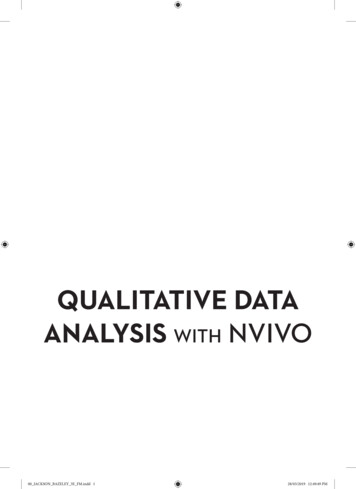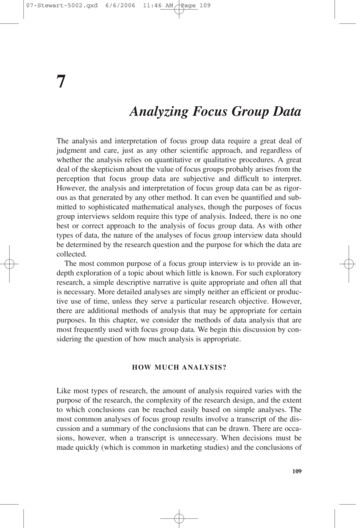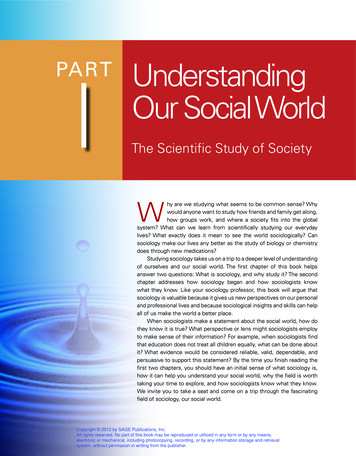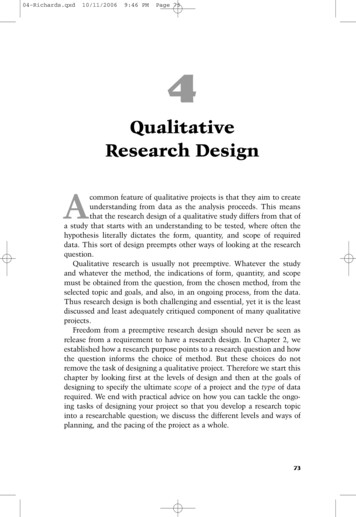
Transcription
04-Richards.qxd10/11/20069:46 PMPage 734QualitativeResearch DesignAcommon feature of qualitative projects is that they aim to createunderstanding from data as the analysis proceeds. This meansthat the research design of a qualitative study differs from that ofa study that starts with an understanding to be tested, where often thehypothesis literally dictates the form, quantity, and scope of requireddata. This sort of design preempts other ways of looking at the researchquestion.Qualitative research is usually not preemptive. Whatever the studyand whatever the method, the indications of form, quantity, and scopemust be obtained from the question, from the chosen method, from theselected topic and goals, and also, in an ongoing process, from the data.Thus research design is both challenging and essential, yet it is the leastdiscussed and least adequately critiqued component of many qualitativeprojects.Freedom from a preemptive research design should never be seen asrelease from a requirement to have a research design. In Chapter 2, weestablished how a research purpose points to a research question and howthe question informs the choice of method. But these choices do notremove the task of designing a qualitative project. Therefore we start thischapter by looking first at the levels of design and then at the goals ofdesigning to specify the ultimate scope of a project and the type of datarequired. We end with practical advice on how you can tackle the ongoing tasks of designing your project so that you develop a research topicinto a researchable question; we discuss the different levels and ways ofplanning, and the pacing of the project as a whole.73
04-Richards.qxd74 10/11/20069:46 PMPage 74T H I N K I N G R E S E A RC HTHE LEVELS OF DESIGNResearch design is created by the researcher, is molded (rather thandictated) by the method, and is responsive to the context and the participants. Creating research design involves seeing the project at differentlevels. Once you have located your project methodologically, you need todesign the pacing of processes and strategies to be used, and at the sametime you need to see the project as a whole.The pacing of the project involves planning the sequencing of itscomponents and the movement between data gathering and data analysis. This requires ongoing decisions during the project: When shouldyou stop interviewing? When do you return to observing—as processesof analysis show that more data are needed to verify, or when thin areasin analysis are revealed? The selection of method informs selectionof research strategies, but these are also chosen in the context ofthe research question (i.e., what you want to find out) and the researchcontext. For example, in studying the experience of menopause in aNewfoundland village, Davis (1983) relied on interviews rather thanobservational data. Richards, Seibold, and Davis (1997) were investigating the social construction of menopause, so they used observation ofwomen’s support groups and information centers as well as many formsof interview.The overall design of the project must be aimed at answering yourresearch question, and we look at detailed examples of design below. Youneed to design a project that both fits and is obtained from the question,the chosen method, the selected topic, and the research goals. You shouldtreat research design as a problem to be considered carefully at the beginning of the study and reconsidered throughout—it is never a given.PLANNING DESIGNWhere to start? If the questions, problem, and method are to guidedesign, then this becomes a highly conceptual and complex process. It ishelpful to start with two questions: What is the scope of this project? andWhat is the nature of the data required?
04-Richards.qxd10/11/20069:46 PMPage 75Qualitative Research Design 75The Scope of the ProjectBy scope, we refer to the domain of inquiry, the coverage and reach ofthe project. Scope involves both the substantive area of inquiry (the limits of the research topic) and the areas to be researched (the setting[s] andthe sample).Definitions of the topic and the relevant concepts and theories asperceived by other investigators in part delimit the area of inquiry.Consideration of the scope of the study continues in the process of gathering and analyzing data. You must work carefully and in depth, withoutlosing sight of the research goals; remain flexible, self-critical, and, at alltimes, analytic; and use the literature as a comparative template. Codingdecisions demand that you constantly ask: “Is this an instance of this category, or is it something different?” During the project, you must continually revisit the substantive scope of inquiry. If the data do not fit thequestion, analysis is likely to lack clear focus; the project may take toolong to saturate and conceptualize and so, frustratingly, may achieve verylittle. On the other hand, if the scope is set too rigidly too early, the studywill be severely limited. Avoid preemptively committing your study todefinitions of the phenomenon of interest and concepts from the literature, thereby predetermining meanings of concepts; avoid making decisions too early in the study and drawing conclusions too quickly. Suchpreemptive scoping will result in premature closure.The scope of the sample and the selection of the setting are driven bytwo principles. One is that setting and sample are purposively selected.This may involve choosing the “best,” most optimal example of the phenomenon and the setting in which you are most likely to see whatever itis you are interested in. It may involve observing or interviewing expertsin that particular topic or experience. Alternatively, you may select a setting because it allows you to obtain examples of each of several stancesor experiences. The study may proceed by snowball sampling (seekingfurther participants by using the recommendations of those participantsalready in the study).The second principle of sampling is that once you have begun to understand whatever it is you are studying, your sampling strategies normallyare extended through theoretical sampling (Glaser, 1978). This means thatyour selection of participants is directed by the emerging analysis, andthe theory being developed from data is subsequently modified by data
04-Richards.qxd76 10/11/20069:46 PMPage 76T H I N K I N G R E S E A RC Hobtained from the next participants. The scope of a study is never just aquestion of how many, but always includes who, where, and which settings will be studied; in what ways, by whom, and for how long they willbe studied; and what can be asked and answered. All of these questionsmust be asked repeatedly as the project progresses. The research questionmay require that you seek out negative cases (examples of experiences thatare contrary to cases that support the emerging theory, and that providenew dimensions, perhaps as indicated by the theory but not yet encountered) or thin areas from participants who have experienced special conditions that have been identified as significant. The scope of a project isbigger than its sample, for participants provide information about otherslike them or unlike them. Such “shadowed data” (Morse, 2001) provideyou with further direction for your theoretical sampling. When sampling,you must be aware of when you are working inductively and discoveringand when you are working deductively and verifying.The interrelationship of the two components of scope becomes clearduring the processes of data gathering and analysis. You need to ask constantly, “What scale of data and what range of settings and sources of datawill give the strands required for this question, this topic, this method,this audience, this disciplinary or political context?” Asking and answering these questions about the project will help you to locate it, to establish the bounds of the question to be addressed and the goals to berethought and realistically revised.Designing the ScopeScoping is an ongoing process in a project. It is rare for a qualitativeresearcher to set a scope and stick to it. Adjustments to the mode of making data are frequently required so that the project can be data driven. Butthis does not mean that such changes can “just happen.” Changes ideallybuild upon the researcher’s growing understanding of the situation.We recommend that you always keep in mind the following issuesregarding scoping:The substantive scope of a project involves issues of comparison(“Will I understand the wider situation if I stay in this group?”) and intervention (“Before I influence policy, how would I know if I were wrong?”).How many perspectives are needed? It is hard, for example, to studyrelationships only by observing interaction. If your question is about the
04-Richards.qxd10/11/20069:46 PMPage 77Qualitative Research Design 77relations between management and staff, you need to observe, if possible,but you must interpret your observations strictly in terms of yourpresence. You will also need other data sources; you need to talk to themanagers and the staff, and you should examine relevant documents.These data sources will provide conflicting information—and you as theresearcher have to make sense of the contradictions.Scoping for change involves asking if this is a study of a process(most qualitative studies are) and, if so, what time period it involves.Beware of studying a process with static data. One-off interviews, forexample, will give interviewees’ accounts, or the versions they see asappropriate in the interview situation, of what happened in the past. Isthis the process and are these the perceptions you need?Scoping for diversity involves examining the sample, asking questions like “Is the research question comparative? If so, how do I achievean adequate comparative base?” As you come to understand gender, race,or class divisions, new issues of scope will emerge (“If I observe onlythose folks, I will not be accepted over there”). Scoping for diversityinvolves considering the scale of the research question (“Whose experience will I not hear?”). It requires attention to representation (“What is itthat I want to make statements about? Does what I won’t see matter?”).It also requires attention to the areas to be covered (“Is there more thanone perspective on this issue?”).As you reevaluate each of these issues, the answers will shift inresponse to your discovering, theorizing, and constructing theory. Scopingthe project almost always shifts the question in the interplay betweenwhat can realistically be asked and what can properly be discovered.The process moves the question from a research question to a researchable one.The Nature of the DataHow will you create data, and how will you ensure a fit of data to theresearch task? These are different questions. They require you to explorethe possible ways of constructing data within a setting and to selectmethods that will combine to ensure that the data will be sufficientlyrich, complex, and contextual to address the question and support therequired analysis.
04-Richards.qxd78 10/11/20069:46 PMPage 78T H I N K I N G R E S E A RC HThus, rather than preparing a research instrument for use throughoutthe project, in undertaking the design of a qualitative study, you need toconsider carefully the variety of approaches available and the sorts of datathey generate. Predesigned research instruments may be useful for sometasks (e.g., a survey form may be used to record basic demographic dataabout participants). But because the goals of the project include learninginductively from the data, instruments designed entirely in advance willrarely support an entire project.You should expect that an interesting research question will usuallyrequire several strategies for making data. Relying on one technique mayproduce homogeneous data, which are highly unlikely to provide enoughsources of understanding and ways of looking at a situation or a problem.Commitment to one sort of data makes the techniques of theoretical sampling very difficult to follow, so you need to resist the easy route of selecting one technique and building in the assumption that you will “do focusgroups” or “do in-depth interviews.” Keep asking, “Why would this oneway of making data suffice to answer my question?” We share a concernwith other scholars regarding the increasing homogeneity of data in qualitative projects as the dominant mode of uniform, as “in-depth” interviewstake over from the previous speckled diversity of qualitative data. Ouradvice is that you not look first for a technique of making data with whichyou are familiar or that you have been trained to do, but rather ask how,in this situation, you can best access accounts of behavior and experience,best weigh the different versions of “reality,” and best interpret them.You should expect that the nature of the data will change during yourproject. The importance of knowing a budget and timeline can easily overtake the requirement of growing a project informed by the data. Startingwith the assumption that they are “doing interviews,” researchers are easily led to see as the only relevant question the issue of how many respondents they should “do.” (We recommend reflection on discoursehere—both about what you are proposing and how you are expressing it.)Even the most expert researchers cannot answer the sample size questionwithout involvement in the project. What constitutes a large enough sample will be determined in the future by the situation studied and the quality of data. But the fact that the question is asked should alert you to itscorollary: “What else could or should I be doing to create a strong and richdata set?”Focus on the end, not only on the beginning, of the project, and particularly on the claims to be made (“What am I asking of these data?” “Whattypes and combinations of data do I need to create?”). Try to foresee theadequacy of likely results (“What will I not see if I
that the research design of a qualitative study differs from that of a study that starts with an understanding to be tested, where often the hypothesis literally dictates the form, quantity, and scope of required data. This sort of design preempts other ways of looking at the research question. Qualitative research is usually not preemptive. Whatever the study
